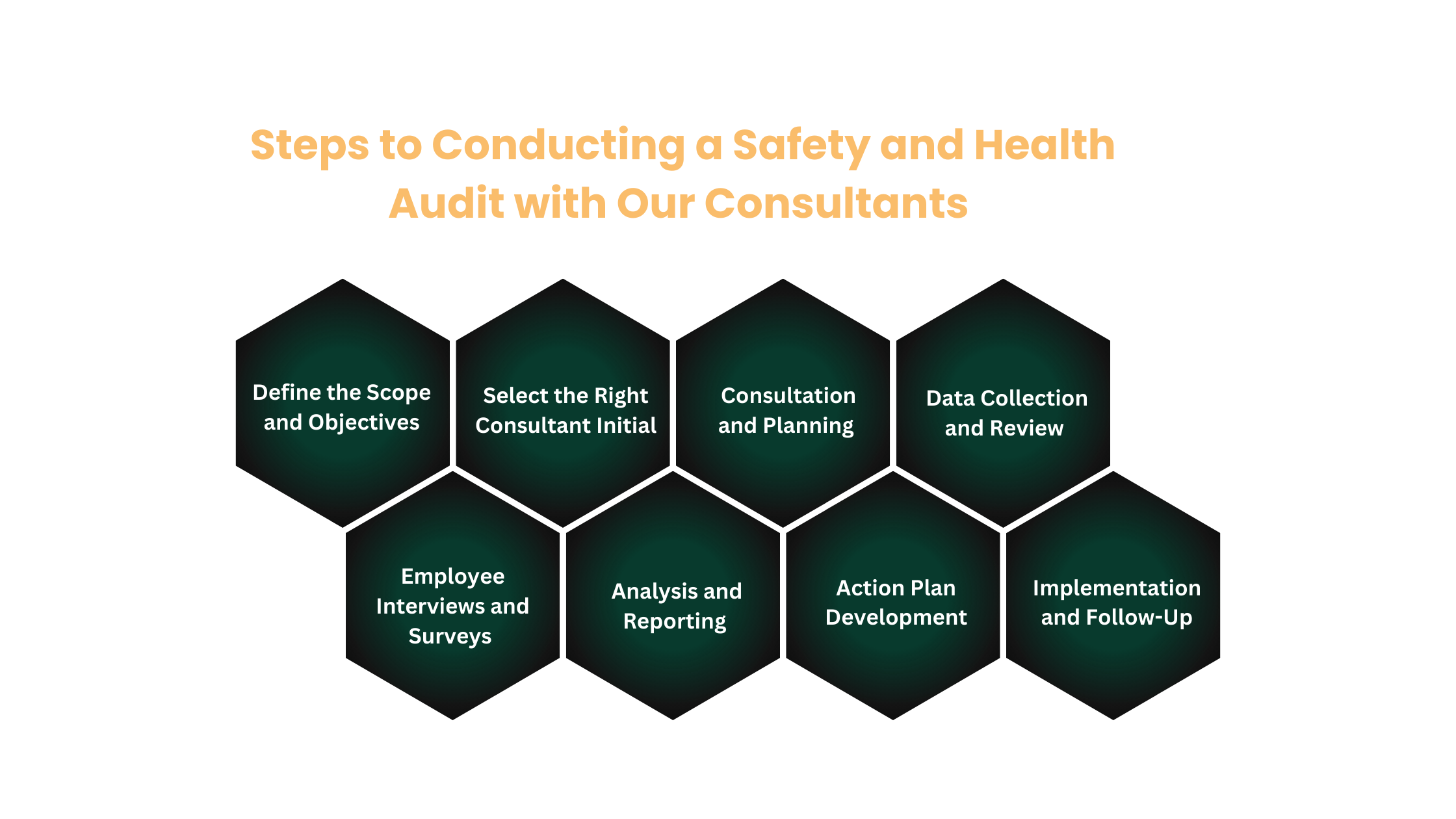How to Conduct a Safety and Health Audit with a Consultant

Related Posts




 Health and Safety Act: 50 Years CelebrationAug 8, 2024
Health and Safety Act: 50 Years CelebrationAug 8, 2024
How can you work with a consultant for a safety and health audit?

Keeping your workplace safe and running smoothly is super important, and a safety and health audit helps with that. It involves taking a good look at how everything works, what rules are in place, and the general environment to find any potential issues and ensure everything's up to snuff. Our approachable and experienced consultants will guide you through the whole thing, making it easy and thorough.
In this article, we will learn the detailed procedure of the audit process of safety and health.
What is a Safety and Health Audit?
A health and safety audit is a process of identifying health and safety policies, practices, and systems to guarantee compliance with the standards. These audits are conducted by unbiased, accredited experts.
Why Use Our Safety and Health Consultation Services?

Using our safety and health consultation services provides various benefits:
- Expertise: Our consultants understand industry-standard safety rules.
- Objectivity: We provide an unbiased viewpoint, which helps detect issues that internal teams may overlook.
- Efficiency: Our staff can expedite the audit process, ensuring that all safety concerns are properly addressed.
- Compliance: We state that your business complies with all relevant health and safety laws.
Steps to Conducting a Safety and Health Audit with Our Consultants

- Specify the goals and scope.
The first step of the audit is to establish the objectives and parameters. Find out the exact domains and protocols that require auditing. Our health and safety consultancy will answer questions like this:- What are the main safety concerns?
- Which departments or operations demand a thorough review?
- Are there any recent incidents or near-misses that warrant investigation?
- Select the Right Consultant
Choosing the right health and safety expert is critical. To choose the consultant from our team that best fits your firm, consider the following factors:- Experience: Our staff are experts in many different kinds of fields.
- Credentials: We own all necessary licences and certificates.
- Reputation: We have received positive reviews from prior clients.
- Local knowledge: Our consultants are conversant with local legislation and requirements.
- Initial Consultation and Planning
Arrange an initial meeting to explore your objectives and expectations. This meeting helps our consultant understand your company's operations and safety culture. Key points to discuss include:- Audit Goals: State clearly what the audit's goals are.
- Create a realistic schedule for the audit process.
- Resources: Determine the resources and staff needed for the audit.
- Data Collection and Review
Our expert will start by gathering pertinent information and analysing existing documentation. This can include:- Safety Policies: Reviewing current safety policies and procedures.
- Incident Reports: Reviewing previous accident and incident reports.
- Training Records: Evaluate the efficacy of safety training programs.
- Inspections: Physically inspecting the workplace to discover any dangers.
- Employee Interviews and Surveys
Our consultant may conduct interviews and surveys with personnel to acquire a thorough insight into the workplace. This helps with:- Identify risks: Discover potential hazards that are not apparent from documentation alone.
- Evaluate Safety Culture: Determine employees' attitudes towards safety.
- Gather comments: Get comments on current safety measures and areas for improvement.
- Analysis and Reporting
After gathering and examining the essential data, our consultant examines it and writes a complete report. This report normally contains:- Risk assessment: Risk assessment is the process of identifying potential dangers.
- Compliance: An assessment of conformity with applicable safety rules.
- Recommendations: Practical suggestions for enhancing safety measures and reducing hazards.
- Action Plan Development
Create a comprehensive action plan based on the consultant's recommendations. This plan should prioritise addressing critical safety issues first.- Assign responsibilities: Assign specific assignments to relevant staff.
- Set deadlines: Set specific dates for executing recommendations.
- Implementation and Follow-Up
Implement the action plan and track progress. Regular follow-up with our consultant helps guarantee that recommendations are effectively implemented. Key actions during this era include:- Instruction: Providing further safety instruction as needed.
- Monitoring: Regularly inspecting workplace conditions to guarantee continued compliance.
- Review: Review and update the safety and health audit regularly to handle new risks and problems.
Conclusion: Enhance Workplace Safety with Our Expert Guidance
The productivity and safety of the company can be increased by collaborating with our safety and health experts. For complete and efficient safety and health audits, follow the above-described steps. A safe workplace protects employees and raises morale and productivity.
So be ready to increase workplace security! Contact with our best health and safety specialists today. Our user-friendly search engine makes hiring professionals easy. Join our organisation today to begin your journey towards a secure and efficient workplace.
FAQs
How often should an audit for safety and health be conducted?
Perform a yearly safety and health audit at the very least. The frequency, however, varies depending on the sector, legal obligations, and particular working circumstances.
What are the key qualifications for a safety and health consultant?
Look for consultants with relevant certifications, extensive industry experience, and a documented track record of successful audits.
Can an internal team conduct a safety and health audit?
Yes, an internal team can carry out an audit. Hiring a consultant could offer an impartial view and specialised knowledge that would not be possible within.
What kind of common challenges are faced during a safety and health audit?
Common issues include reluctance to change, a lack of employee cooperation, and detecting less evident threats. A professional expert can help you negotiate these difficulties efficiently.
How can I ensure continuous improvement in workplace safety after the audit?
Review and update safety policies regularly, give ongoing training and maintain open communication with employees to address new risks and issues as they arise.
